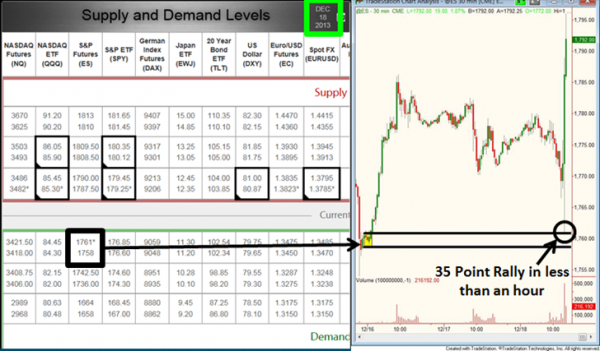![]()
During our development years, we are taught/conditioned to think certain ways. Our years in grammar school, high school, and university are key belief system building years. One of the major conflicts during these years occurs when we are taught how to buy stocks and then how we are taught to buy and sell anything else in our life.
The basic principle of buying low and selling high or selling high and buying low is how we derive profit when buying and selling anything. When we buy cars or houses, we never offer what the seller is asking. We always offer a lower price and typically end up somewhere in the middle. Smart shoppers look for deals where they can buy what they are looking for at a lower price than others pay. We all typically try or desire to buy at “wholesale” prices and sell at “retail” prices, just like any successful company does. At this point, most of you are thinking that I am wasting your time because you know this already and that’s true. However, during the years that we are conditioned to buy low and sell high, we are almost taught to take the opposite action with our investments either long term or in short term trading.
For example, at every level in school when we are taught to buy stocks as investments, we are told to wait for certain criteria to become true BEFORE we buy. These criteria include but are not limited to:
Good company
Strong earnings
Healthy balance sheet
Quality management
Stock price trending up
Moving averages sloping higher
When all these criteria are true, WHERE DO YOU THINK THE PRICE OF THE STOCK IS? It will almost always be high, at or near retail prices when these criteria are true which means you will be paying $50,000 for the $30,000 car and the seller is the big winner, not you. The way we are taught to buy stocks is completely opposite of how we are taught to buy and sell anything else and therein lies the major conflict… When news is bad, people want to sell. When it’s perceived good, people generally want to buy.
Last Wednesday, everyone was waiting for the Fed news to come out in the afternoon. There was more and more talk about whether the Fed would scale back on its bond buying program that many think has been inflating the stock market. The mass perception was that as soon as the Fed decides to scale back, the Stock market record rally would be over. While the argument seems to make sense, the markets supply and demand as seen on the chart below suggested something else.
December 18th, Fed News Day
That morning, our Supply / Demand grid in the Mastermind Community had a demand level in the S&P at 1758 – 1761. Prior to the Fed announcement later that day, the S&P was trading around 10 points higher. Then, the big moment… The Fed announces they will begin scaling back their program and the stock market (S&P) collapsed. However, once it reached our level of demand, priced stopped falling and shot up like a rocket. In 2 days, it rallied more than 50 points from our demand level of 1761 to 1817.
How can this happen? The market was supposed to fall on this news! Simple, sellers did sell in big numbers on the release of that news, overwhelming the demand at those price levels. However, once price declined to a level where demand exceeded supply, and the last of the sell orders at that level was filled, there was only one direction for price to go – UP. And, since all the sellers that were going to sell on that news had sold, there was no real supply left to stop the rally. As I have said so many times, it’s all about quantifying the buy and sell orders.
Most people are so consumed with pattern recognition, conventional technical and fundamental analysis. They forget the simple buying and selling action they take at the grocery store each week where they regularly try to buy low and sell high which is the key to trading success. Whether its Costco, Walmart, Goldman Sachs, your local convenient store, or the 6 year old selling lemonade in front of their house, how price moves in markets and how money is made and lost in markets never changes.
Hope this was helpful. Have a great day.
Note: All information on this page is subject to change. The use of this website constitutes acceptance of our user agreement. Please read our privacy policy and legal disclaimer. Opinions expressed at FXstreet.com are those of the individual authors and do not necessarily represent the opinion of FXstreet.com or its management. Risk Disclosure: Trading foreign exchange on margin carries a high level of risk, and may not be suitable for all investors. The high degree of leverage can work against you as well as for you. Before deciding to invest in foreign exchange you should carefully consider your investment objectives, level of experience, and risk appetite. The possibility exists that you could sustain a loss of some or all of your initial investment and therefore you should not invest money that you cannot afford to lose. You should be aware of all the risks associated with foreign exchange trading, and seek advice from an independent financial advisor if you have any doubts.
Editors’ Picks
AUD/USD post moderate gains on solid US data, weak Aussie PMI

The Australian Dollar registered solid gains of 0.65% against the US Dollar on Thursday, courtesy of an upbeat market mood amid solid economic data from the United States. However, the Federal Reserve’s latest monetary policy decision is still weighing on the Greenback. The AUD/USD trades at 0.6567.
EUR/USD recovers to top end of consolidation ahead of Friday’s US NFP

EUR/USD drove back to the top end of recent consolidation on Thursday, recovering chart territory north of the 1.0700 handle as market risk appetite regains balance heading into another US Nonfarm Payrolls Friday.
Gold recoils on hawkish Fed moves, unfazed by dropping yields and softer US Dollar

Gold price clings to the $2,300 figure in the mid-North American session on Thursday amid an upbeat market sentiment, falling US Treasury yields, and a softer US Dollar. Traders are still digesting Wednesday’s Federal Reserve decision to hold rates unchanged.
Ethereum may sustain trading inside key range, ETH ETFs to be delayed until 2025

Ethereum is beginning to show signs of recovery on Thursday despite a second consecutive day of poor performance in Hong Kong's spot Ethereum ETFs. Bloomberg analyst James Seyffart has also shared that a spot Ethereum ETF may not happen in the US in 2024.
FOMC in the rear-view mirror – NFP eyed

The update from May’s FOMC rate announcement proved more dovish than expected, which naturally weighed on the US dollar (sending the DXY to lows of 105.44) and US yields, as well as, initially at least, underpinning major US equity indices.
RECOMMENDED LESSONS
Making money in forex is easy if you know how the bankers trade!
Discover how to make money in forex is easy if you know how the bankers trade!
5 Forex News Events You Need To Know
In the fast moving world of currency markets, it is extremely important for new traders to know the list of important forex news...
Top 10 Chart Patterns Every Trader Should Know
Chart patterns are one of the most effective trading tools for a trader. They are pure price-action, and form on the basis of underlying buying and...
7 Ways to Avoid Forex Scams
The forex industry is recently seeing more and more scams. Here are 7 ways to avoid losing your money in such scams: Forex scams are becoming frequent. Michael Greenberg reports on luxurious expenses, including a submarine bought from the money taken from forex traders. Here’s another report of a forex fraud. So, how can we avoid falling in such forex scams?
What Are the 10 Fatal Mistakes Traders Make
Trading is exciting. Trading is hard. Trading is extremely hard. Some say that it takes more than 10,000 hours to master. Others believe that trading is the way to quick riches. They might be both wrong. What is important to know that no matter how experienced you are, mistakes will be part of the trading process.


